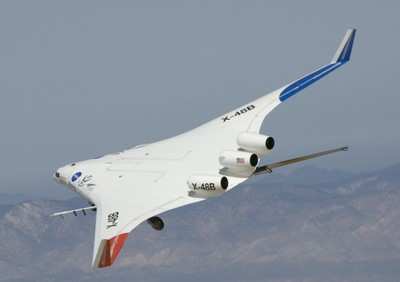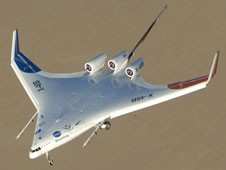Higher Speeds, Cleaner Aerodynamics Will Mark Next Round Of Tests
NASA's Dryden Flight Research Center and The Boeing Co. are expanding the flight envelope for the X-48B blended wing body research aircraft.

Flight tests with the 500-pound, remotely piloted test vehicle are now in a second phase involving higher speed regimes. The 21-foot wing span test aircraft is flying without its slats deployed. Slats are flight control surfaces on the leading edges of wings which, when extended, allow an aircraft to take off, fly and land at slower speeds.
X-48B flight testing is taking place at NASA's Dryden Flight Research Center on Edwards Air Force Base, CA. NASA Dryden is providing critical support to a Boeing-led project team that also includes the U.S. Air Force Research Laboratory in Dayton, OH, and Cranfield Aerospace Ltd., of Bedford, England. "The first flight in the slats-retracted configuration marked another milestone in aviation history and the performance of the X-48 aircraft continues to exceed our expectations," said Tim Risch, NASA X-48B project manager. "This flight milestone reinforced the productive relationship of the NASA, Boeing and Air Force team and NASA's continued commitment to developing the concepts, tools and technologies for the aircraft of the future."
"We want to fully understand the aerodynamics of the blended wing body design all the way up to and beyond stall, so that we can learn how to fly a blended wing body aircraft as safely as any other large transport aircraft with a conventional tail," said Norm Princen, Boeing's X-48B chief engineer. "This latest phase of the flight testing is one more step in the process and we are looking forward to progressing on to more risky flight maneuvers in the months ahead."
Initial envelope expansion flights of the aircraft, known as Block 1, consisted of 11 flights and incorporated slow-speed testing with bolt-on leading edge slats in the extended position. Block 2 flights began on April 4. The X-48B first flew on July 20, 2007. Now with a clean leading edge, the subscale aircraft, dubbed Skyray, takes off and lands at speeds of about 75 knots compared to 60 knots in Block 1. Data will be taken up to a maximum speed of 118 knots.

At least eight flights are scheduled for Block 2. A total of six phases are slated for the project, each progressively increasing the level of risk. The final phase, Block 6, is designed to push the aircraft's flight parameters by testing the departure limiter, a critical part of the flight control software that is designed as a safety feature to prevent the aircraft from departing controlled flight.
NASA's participation in the blended wing body research effort is focused on fundamental, advanced flight dynamics and structural design concepts within the Subsonic Fixed Wing Project, part of the Fundamental Aeronautics Program managed by NASA's Aeronautics Research Mission Directorate, Washington.
Potential benefits of the aircraft under investigation include increased volume for carrying capacity, efficient aerodynamics for reduced fuel burn and possibly significant reductions in noise due to propulsion integration options. In these initial flights, the principal focus is to validate the research on the aerodynamics and controllability of the shape, including comparisons of the flight data with the extensive wind-tunnel database.
In addition to hosting the X-48B flight test and research activities, Dryden provides engineering and technical support – expertise garnered from years of operating cutting-edge air vehicles. Dryden assists with the hardware and software validation and verification process, the integration and testing of the aircraft's systems and the pilot's ground control station. Dryden's range group provides critical telemetry and command and control communications during X-48B flights, while Dryden Flight Operations provides a chase aircraft and flight scheduling. Photo and video support complement the effort.

Members of the Boeing Phantom Works research and technology organization, based in Huntington Beach, CA, designed the X-48B flight test aircraft in cooperation with NASA and the U.S. Air Force Research Laboratory to gather detailed information about the stability and flight-control characteristics of the blended wing body design, especially during takeoffs and landings.
Three small jet engines enable the composite-skinned, 8.5-percent scale vehicle to fly up to an altitude of 10,000 feet. The aircraft is flown remotely from a ground control station with the pilot using conventional aircraft controls and instrumentation while viewing a monitor fed by a forward-looking camera on the aircraft.
 ANN's Daily Aero-Linx (04.15.24)
ANN's Daily Aero-Linx (04.15.24) Classic Aero-TV: 'No Other Options' -- The Israeli Air Force's Danny Shapira
Classic Aero-TV: 'No Other Options' -- The Israeli Air Force's Danny Shapira Aero-News: Quote of the Day (04.15.24)
Aero-News: Quote of the Day (04.15.24) Airborne 04.16.24: RV Update, Affordable Flying Expo, Diamond Lil
Airborne 04.16.24: RV Update, Affordable Flying Expo, Diamond Lil ANN's Daily Aero-Term (04.16.24): Chart Supplement US
ANN's Daily Aero-Term (04.16.24): Chart Supplement US





